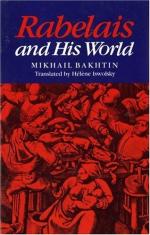
|
| Name: _________________________ | Period: ___________________ |
This test consists of 15 multiple choice questions and 5 short answer questions.
Multiple Choice Questions
1. What does Bakhtin argue is the role of dialogue?
(a) To give one character a strong voice.
(b) To move the plot along.
(c) To demonstrate thinking out loud.
(d) To oppose the authoritarian word.
2. Bakhtin thinks that life is:
(a) Meaningless and futile.
(b) A sacrifice the soul makes to the body.
(c) Inert, chaotic, and requiring the intervention of art.
(d) Organized by human acts of behavior and cognition.
3. To what does Bakhtin compare the various cries of Paris?
(a) A crowded kitchen.
(b) A howling wolf.
(c) A sobbing child.
(d) A roaring storm.
4. Bakhtin considers "thrashing" ambivalent, rather than strictly negative, because:
(a) The one who is thrashed is also decorated and celebrated.
(b) The one who is thrashed explicitly agrees to the act.
(c) The act of thrashing is done to punish the individual.
(d) The act of thrashing is done out of kindness.
5. How, according to Bakhtin, does the current Russian literary criticism approach Rabelais' works?
(a) By sharing them with an eager public.
(b) By trying to correctly interpret the source of the cultural laughter within them.
(c) By denouncing them as counterproductive to the ongoing Russian Revolution.
(d) By reviving their content in new, twentieth-century forms.
6. The combination of solemnity and joking in the tone of the Prologue to the Third Book indicates:
(a) The complex explanation of the Prologue to the readers.
(b) The confusion the author experiences with this combination.
(c) The importance and necessity of laughter.
(d) The opinion that humor must be subordinate to seriousness.
7. Who is Janotus de Bragmardo?
(a) A market vendor scheming to cheat Gargantua.
(b) A scholar sent to recover church bells from Gargantua.
(c) A clown who mocks Gargantua at Carnival.
(d) A robber who stumbles across Gargantua's treasure.
8. The core images of the prologue of _Gargantua_ are:
(a) Scenes of travel and journeys.
(b) Scenes of pious worship.
(c) Scenes of eating and drinking.
(d) Scenes of violence.
9. What event that Rabelais relates does he assert is the origin of the name of the city of Paris?
(a) A battle won by the French against the English.
(b) Gargantua's drenching of the city in urine.
(c) Pantagruel's education in the druggists' shops.
(d) An earthquake that disrupts Carnival.
10. What are the targets of the abusive language in Rabelais' prologue to the Third Book?
(a) Foreign travelers who have offended the traditions of Carnival.
(b) Average townsfolk who have imbibed too much wine.
(c) Representatives of old, hypocritical, serious Medieval philosophy.
(d) Members of the aristocracy whose political ideals are not in keeping with Rabelais' ideals.
11. What does the "form" of any kind of art express?
(a) The materials from which the art is constructed.
(b) Whatever the audience chooses.
(c) Only one possible message.
(d) A system of values.
12. What were "street cries"?
(a) The sobs of orphans who live on the street.
(b) The warnings people yell when they throw the contents of their chamber pot out the window.
(c) The shouted, versified advertisements of market vendors.
(d) The calls of the city bellringer telling the time.
13. Bakhtin associates Friar John's beating of the men with:
(a) Market vendors who assault non-paying customers.
(b) Juvenalian satires of public figures.
(c) The Dionysian feast of the grape harvest.
(d) The last charge of Charlemagne.
14. What type of work did Rabelais often publish, especially for the fairs?
(a) Political treatises.
(b) Calendars or almanacs.
(c) Religious tracts.
(d) Biographies of public figures.
15. Bakhtin asserts that the advertisement for "pantagruelion" in the Third Book expresses:
(a) The existentialist confusion of Renaissance marketplace culture.
(b) The natural mistrust the common folk have for druggists.
(c) The cynicism rampant in Rabelais' writing.
(d) The deep optimism inherent in Rabelais' view of marketplace culture.
Short Answer Questions
1. Mikhail Bakhtin is:
2. In Rabelais' works, some causes of diseases associated with the material body lower stratum are:
3. The prologue of _Pantagruel_ is a parody and travesty of:
4. What work of literature is parodied in the prologue of _Gargantua_?
5. Why, according to Bakhtin, is Rabelais' parody of the Church not considered heresy?
|
This section contains 752 words (approx. 3 pages at 300 words per page) |

|




